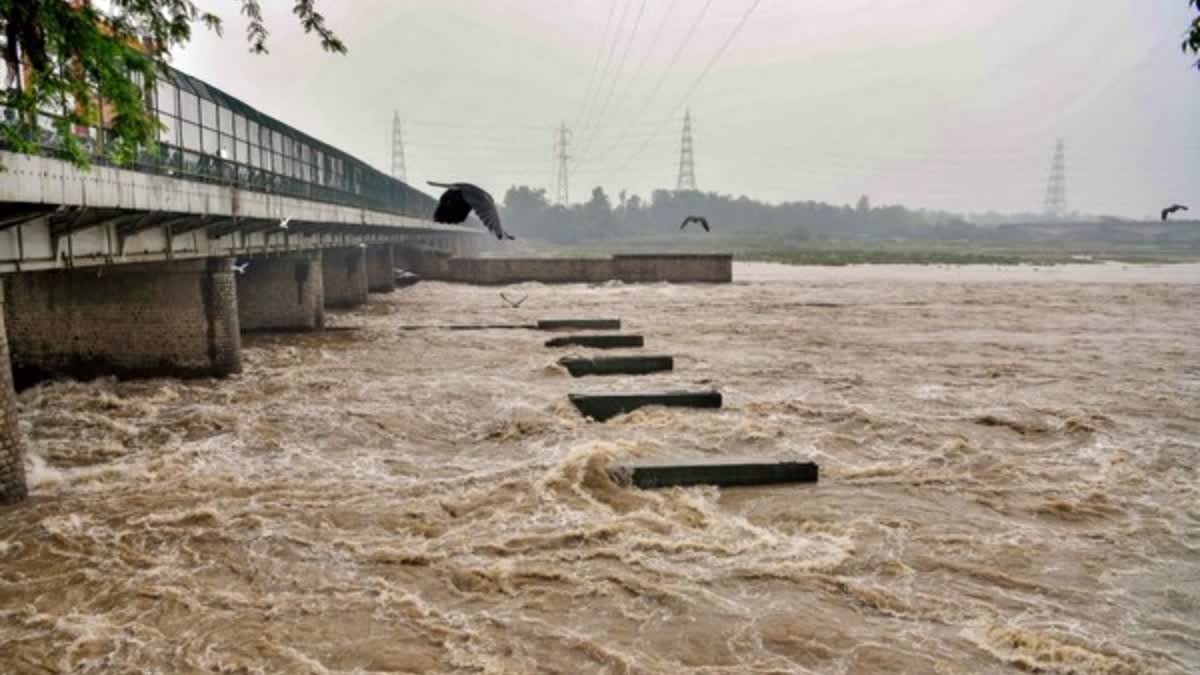New Delhi: The water level in Yamuna River touched 206. 38 meters, slightly above the danger mark of 205.33 meters, Central Water Commission said on Tuesday. As per the CWC officials, the high flood level is--207.49 meters. "The water level in Yamuna River crosses the danger mark of 205.33 mtr, touching 206.38 mtr; the high flood level is--207.49 mtr," the CWC official said.
According to the Central Water Commission's (CWC) flood-monitoring portal, the water level at the Old Railway Bridge rose from 205.4 metres at 5 pm on Monday to 206.38 metres at 12 noon on Tuesday with Haryana releasing more water into the Yamuna from the Hathnikund barrage in Yamunanagar. It is expected that the river will rise to 206.75 metres by 6 pm.
Rail traffic suspended-The Rail traffic over the old Yamuna bridge in Delhi has been temporarily suspended since 6.00 a.m, today till July 11, said Northern Railway. Meanwhile, rise in water level in Yamuna was also seen at Vikasnagar, in Uttarakhand's Dehradun due to continuous rainfall. Earlier, the water level of the Yamuna at the Old Railway Bridge was recorded at 206.04 mm at 11 pm on Monday.
Danger mark-The Yamuna River in Delhi, which was flowing above warning level for hours, crossed the danger mark of 205.33 metres at 5 pm on Monday, the latest data from the flood control department said. The water level in Yamuna is rising continuously as Haryana released more water into the river from the Hathnikund barrage amid rains across northwest India including the national capital.
According to the Flood Control Department, around 2,15,677 cusecs water was discharged through the Hathnikund barrage at 3 pm on Monday. A fresh spell of rainfall lashed the city on Monday afternoon. The areas in the city continued to face water-logging due to incessant rains on Saturday and Sunday and a fresh spell of rainfall on Monday.
Evacuation of people from low-lying areas-Addressing a press conference on Monday, Chief Minister Arvind Kejriwal said a flood-like situation is unlikely in Delhi, but the city government is prepared to tackle any eventuality. Kejriwal had said the evacuation of people from low-lying areas will start once the river breaches the 206-metre mark. An official from East Delhi district said the evacuation process began on Monday night after floodwaters entered some areas.
"Only those living in the affected areas have been shifted to camps on higher grounds," he said. According to the CWC, the flow rate at the Hathnikund barrage increased to 3,44,035 cusecs at 10 am and further to 3,59,760 cusecs at 11 am. FNormally, the flow rate at the barrage is 352 cusecs, but heavy rainfall in the catchment areas increases the discharge. One cusec is equivalent to 28.32 litres per second. The water from the barrage takes around two to three days to reach Delhi.
The India Meteorological Department (IMD) said heavy rain pounded several places in Uttarakhand and Himachal Pradesh overnight, raising concerns about a further rise in the water level in rivers. The Delhi government issued a flood warning on Sunday. Authorities have been instructed to stay vigilant and take necessary action in vulnerable areas. Quick response teams and boats have also been deployed.
The Delhi government has set up 16 control rooms to monitor the flood-prone areas and the water level of the Yamuna. More than 50 motor boats have been deployed for rescue-and-relief operations, and diving and medical teams have been readied with all the necessary materials and equipment. Northwest India has seen incessant rainfall over the last three days, with many areas in Jammu and Kashmir, Uttarakhand, Himachal Pradesh, Haryana, Uttar Pradesh and Rajasthan recording "heavy to extremely heavy" precipitation.
This has resulted in overflowing rivers, creeks and drains that have massively damaged infrastructure and disrupted essential services in Jammu and Kashmir, Himachal Pradesh, Uttarakhand and Punjab. Delhi witnessed its highest rainfall (153 mm) in a single day in July since 1982 in the 24-hour period ending at 8:30 am on Sunday. The city received an additional 107 mm rainfall in the subsequent 24 hours, exacerbating the situation. The heavy rain transformed roads into gushing streams, parks into watery labyrinths and marketplaces into submerged realms.
In response to the torrential rain, the Delhi government announced a closure of all schools on Monday and cancelled the Sunday leave of government officials, instructing them to be in the field. The Yamuna river system's catchment covers parts of Uttar Pradesh, Uttarakhand, Himachal Pradesh, Haryana, Rajasthan, Madhya Pradesh and Delhi. The low-lying areas near the river in Delhi are considered prone to flooding and are inhabited by around 41,000 people.
Encroachments on the river floodplain have occurred over the years, despite the land belonging to the Delhi Development Authority (DDA), revenue department and private individuals. The Yamuna breached the danger mark twice in September last year, with the water level reaching 206.38 metres. In 2019, the river witnessed a peak flow rate of 8.28 lakh cusecs on August 18-19 and the water level rose to 206.6 metres. In 2013, it reached a level of 207.32 metres. The river had swollen to an all-time record water level of 207.49 metres in 1978. (With agency Inputs)



